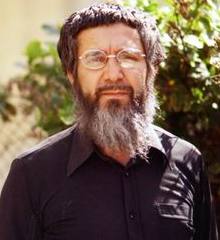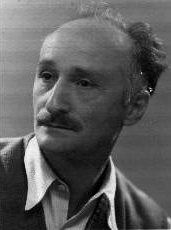
Zeev Kun (born 16 April 1930) is an Israeli painter of Hungarian origin. He is the father of the artist Shay Kun.

Zeev Kun (born 16 April 1930) is an Israeli painter of Hungarian origin. He is the father of the artist Shay Kun.
Zeev Kun was born in the city of Nyíregyháza in northeastern Hungary. As a teenager, he worked at an art supply store owned by his parents, Blanka and Sandor. After the deportation of Hungarian Jews began in March–April 1944, 14-year-old Zeev Kun was first sent to Auschwitz concentration camp, then to Jaworzno concentration camp, located 23 kilometers away from Auschwitz and used as its outer branch, and from January to April 1945 he was imprisoned at the camps of Gross-Rosen, Buchenwald and Flossenbürg; [1] on April 23, 1945, the prisoners of the camp Flossenbürg were freed by American troops. In late August 1945, Zeev Kun came back to Hungary, and with the Auschwitz concentration camp tattoo still visible on his arm, he resumed school. Later, he entered the Magyar Képzőművészeti Főiskola in Budapest (nowadays called Hungarian University of Fine Arts) in the fall of 1947, where he studied for over a year and a half. In 1949, as the new pro-communist political regime was growing more and more repressive, Zeev Kun joined a group of thirty Jews from the leftist Zionist organization "Hashomer Hatzair" and managed to secretly cross the Czech border, and later he arrived to Italy via Austria. In the city of Bari, the group boarded a ship that brought them to Israel. Once in Israel, Zeev Kun first settled at the kibbutz Givat-Haim near Hadera. He did not stay there for long, though, as in 1951 he became a student at the Akademie der bildenden Künste Wien Academy of Fine Arts in Vienna, [2] as the city had just witnessed the birth of the so-called Vienna School of Fantastic Realism. Students and young professors of the Academy sought to reflect upon the tragedy of World War II, still maintaining a dialog with the masters of German Renaissance (such as Hieronymus Bosch and Pieter Bruegel the Elder), as well as the pioneers of surrealism of 1920s and 1930s, first of all Max Ernst (1891–1976). At the Academy, Zeev Kun was close to Anton Lehmden (born in 1929) and Ernst Fuchs (1930–2015). In his art, the latter focused on the images of Apocalypse, creating paintings shot through with dread and fear of death. It is no wonder that Zeev Kun, who himself survived the nightmare of Auschwitz and Buchenwald, was so overwhelmed by the works of Fuchs, who happened to be his peer. [1] Upon his return to Israel, Zeev Kun joined the Israeli Painters and Sculptors Association. In 1973 he was awarded the prestigious Max Nordau Prize for Arts. [3] His paintings have gained acclaim from art lovers in the Israeli non-Jewish sector, as well; they have been sold by their Alkara Art Gallery in Daliyat al-Karmel, Israel's largest Druze town. [4]
His perfectly mastered technique allowed him to accomplish a wide range of artistic goals, as he came up with philosophic and allegoric interpretations of the Holocaust and its ever-present memory, never to be overshadowed by the Jewish national revival in Israel and in a number of countries hosting Jewish diasporas. He exhibited in many Israeli cities (e.g. Jerusalem, 1954, Tel Aviv, 1959, 1961, 1963, 1964, 1968, [5] 2014), [6] and Nahariya (1988), [7] as well as in Brussels (1960), Paris (1962, 1972, 1994), London (1965), Sydney (1967), New York City (1968), [8] Los Angeles (1968), Detroit (1970), Amsterdam (1972), Stockholm (1975), Antwerp (1976) and Berlin (1987). For many years, the painter worked in Safed, where he held his own gallery, but later he returned to Tel Aviv, where he has lived ever since.
Zeev Kun's works have been successfully sold by leading Israeli auction houses on many occasions, including "Tiroche", "Matsart", "Montefiore", "Egozi" and others. According to art critic professor G.Recanat, Zeev Kun's paintings have always been highly appreciated and valued by art collectors and art lovers. [9]

Igael Tumarkin was an Israeli painter and sculptor.
Joseph Kossonogi was an Israeli painter.
Heddy Kun is an Israeli painter.

Ze’ev Raban (22 September 1890 – 19 January 1970), born Wolf Rawicki (Ravitzki), was a leading painter, decorative artist, and industrial designer of the Bezalel school style, and was one of the founders of the Israeli art world.
Itzchak Tarkay was an Israeli painter and graphic artist. He is used trade dress to protect his style from being emulated via Romm Art Creations Ltd. v. Simcha International, Inc.. A case that Tarkay won.

Malva Schalek, aka Malvina Schalková, was a Czech-Jewish painter. Trained in Prague, she went on to work in Vienna as a painter. From 1942 to 1944 she was imprisoned in the Theresienstadt concentration camp. In 1944 she was moved to the Auschwitz concentration camp, where she died. Many of her works are held in the Ghetto Fighters' House in Israel.

Naftali Wahba Bezem was an Israeli painter, muralist and sculptor.

Yehuda Bacon is an Israeli artist who survived the Holocaust.

Stefan Jerzy Zweig is an author and cameraman. He is known as the Buchenwald child from the novel by Bruno Apitz, Naked Among Wolves. He survived the Buchenwald concentration camp at age four under protection from his father and other prisoners.
Pinhas Golan was an Israeli artist and sculptor. Golan was a Holocaust survivor and his work focused on the subject.

Shy Abady is an Israeli artist. Over the years, Abady created "biographical" series, which followed individual figures .Other series addressed historical-political themes .In some other series,, Abady examines the language of art itself and the aesthetic influences and relationships between Western-Christian art and Jewish-Israeli art. Abady's work has been shown in solo and group exhibitions in many galleries and museums in Israel and abroad.
Aharon Gluska is an Israeli–American painter.
Zvi Malnovitzer is an expressionist painter born to a Haredi, or ultra-Orthodox, religious family in Bnei Brak, Israel. His upbringing in a society isolated from the modern world, where he was dedicated to intensive and uninterrupted Talmudic study from a young age, makes his decision to become an artist unusual, bold, and one of accomplishment. During his training in Reichenau, Austria, where he studied under the auspices of artist Wolfgang Manner and under the direction of Ernst Fuchs, Malnvotizer developed a unique style portraying themes that straddle the religious and secular worlds.

Nir Hod is an Israeli artist based in New York.
Eugen Kolb was an art critic, theorist of art and director of the Tel Aviv Museum of Art from 1952 until his death in 1959.

Alexander Bogen was a Polish-Israeli visual artist, a decorated leader of partisans during World War II, a key player in 20th century Yiddish culture, and one of the trailblazers for art education and Artists' associations in the emerging state of Israel.
Shay Kun is an Israeli-American painter known for post-modern interpretation of the Hudson River School movement. He is the son of Israeli painter Zeev Kun.
Jakob Eisenscher (1896–1980) was born in the Austro-Hungarian Empire. He was an Israeli artist.

Esther Lurie was an Israeli painter.

Tova Berlinski was a Polish-born Israeli painter who was considered to be a doyenne of the painting community in Jerusalem.